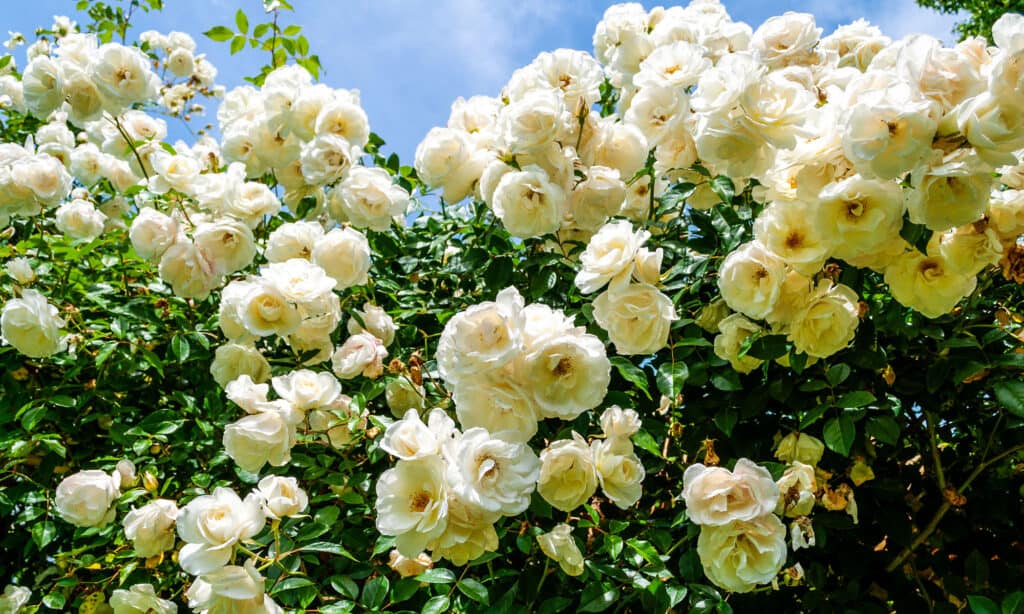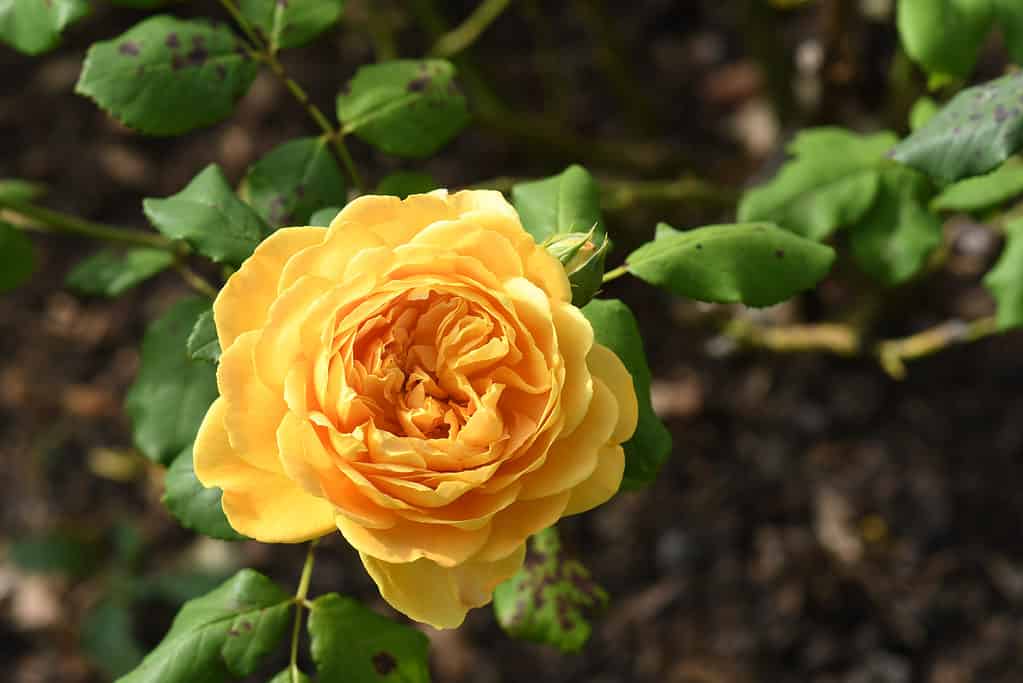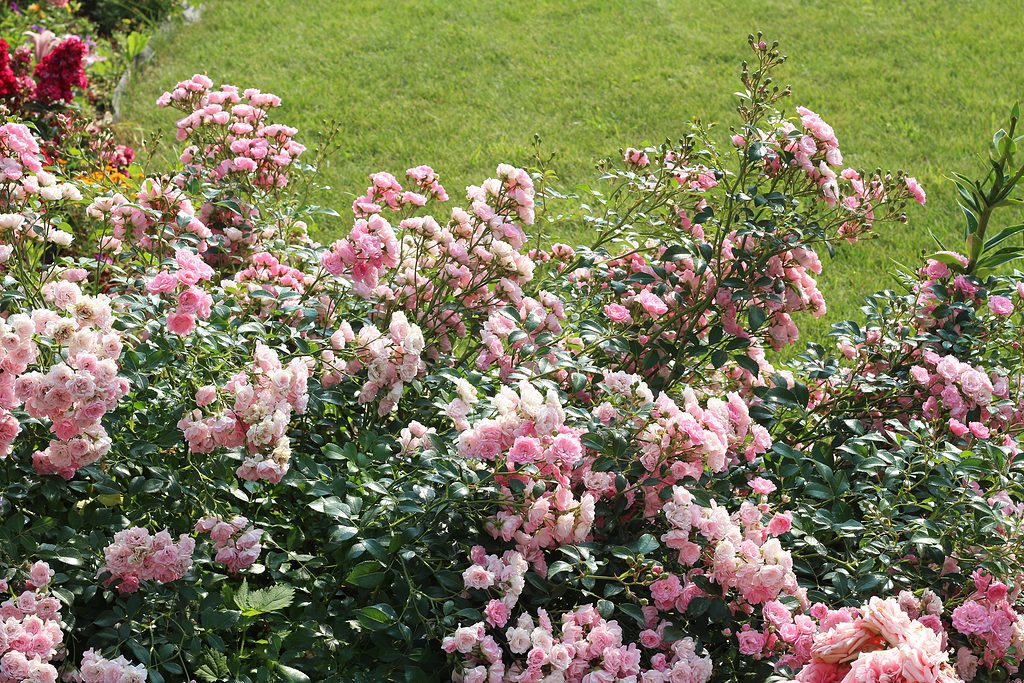The rose, which may be produced as solitary stalks, bushes, climbing plants, or trailing plants, is the most often used perennial blooming plant in landscaping. The vividly-colored petals of the rose are a universal emblem of passion, making it one of the most well-liked and well-known flowering plants.
In the plant family Rosaceae, which has around 300 naturally occurring species of roses in addition to tens of thousands of cultivated variations, the genus Rosa is where roses are categorized. Since all roses are plants that emerge from the ground without a single wooden trunk separating the roots from the branches, all rose species are technically considered bushes or shrubs.
While all roses are technically bushes, some have more of a climbing inclination or a single-stalk habit than others. Hence they are categorized into many types. In this guide, we’ll take a look at a few varieties of rose bushes that are, well, bushy. These varieties tend to stay in a traditional bush or shrub-like form, making them best for use as hedges or potted plants in landscaping.

Rose bushes (pictured) will usually take on a clustered, semi-large form that can be easily controlled with pruning.
©GAT0/Shutterstock.com
How to Care for Rose Bushes
You may plant rose bushes in the spring or fall. Be cautious to wait until all threat of frost has passed before planting in the spring. Depending on your zone, this occurs often between mid-April and May. When planting roses in the fall, remember to plant them about six weeks before the first typical frost. Before they become dormant, planting roses in the fall will help them build roots.
Deadheading is an excellent habit to keep your rose healthy and lovely. This is crucial for repeat-bloomer rose bushes to promote the subsequent flush of flowers. Removing wasted blossoms also aids in keeping your plant’s surface free of fungus. When deadheading a rose, cut the stem just beneath the flower’s head and above the first row of leaflets that are closest to the bloom. To prevent harming the shrub, use sharp shears. Roses don’t need to be pruned, but it’s an excellent habit to form. You may leave your rose bush alone if you want it to appear very bushy. However, pruning can also assist you in managing the bush’s form.
The Benefits of Growing Rose Bushes
When gardeners and rose aficionados discuss shrub or bush roses, they rarely confine the conversation to very specific varieties. Any rose with exceptional garden characteristics, and a bushy look will be included. So what are some beneficial characteristics of such roses?
To start, bush roses have the advantage of being easy to grow. A novice should be able to cultivate a nice shrub rose without a ton of effort.
Just as well, shrub roses simply look lovely in gardens. A fantastic example would be hybrid teas. However, it could be difficult to argue that most hybrid tea plants seem as lovely in a landscape as their flowers do in a vase. Even though they may produce bouquet-quality flowers, shrubs are useful in the landscape and are mainly used as such.
Growing Rose Bushes Tips
Another characteristic of superior bush roses is disease resistance. Currently, disease resistance is rose breeding’s coveted goal. While resistance is getting better across the board for roses, shrubs have the best chance of avoiding harsh diseases.
Many types of bush roses are also hardy. Over the years, several hybridizers have sought to create attractive shrub roses that can withstand the harsh northern winters, and they have unquestionably succeeded.
Another benefit of bush roses is their unusual flowers. Many people believed for a very long time that a real rose always had to resemble a hybrid tea, thanks to florists and illustrators. As a result, many lovely roses were passed over because they didn’t live up to that standard. If you enjoy single and vintage-style roses, you will appreciate the renewed interest in shrub roses because it is there that many beautiful but unusual flowers find their calling. Although the size of the flowers on shrub roses varies, you’ll notice that some contribute to profusions of blossoms, even though each one may not be very noteworthy.
The advantage of aroma is another benefit of planting rose bushes. Modern hybrid teas have an understandable flaw: they frequently lack any smell at all. While some shrub roses are odorless, most have a pleasant aroma that can fill a whole garden.
Now that we know a bit more about rose bushes let’s look at some popular types of rose bushes and varieties.
Golden Celebration Rose
Botanical Name: Rosa ‘Golden Celebration’
Flowers from the Golden Celebration rose to have a lot of petals. Per flower, there may be up to 75 petals. These petals are unlike many other rose varietals in terms of color. The Golden Celebration rose boasts vibrant yellow blossoms as opposed to the more typical red or pink flowers.
Compared to other cultivars of roses, the Golden Celebration rose is also a bit bigger. When fully grown, the mature height of this slender upright shrub can reach around eight feet. This variety may be grown as a bushy shrub or a climbing vine and has a little arch to its branching habit. It demonstrates a robust resistance to illnesses in either situation.
USDA hardiness zones four through nine are suitable for growing this rose. It will likely reach eight feet in height and eight feet in breadth. The soil should have a reasonable amount of moisture for this type, but not too much.

The yellow Golden Celebration rose (pictured) is beloved for its bright yellow flowers.
©Helen M.A. Rogers/Shutterstock.com
Fairy Rose
Botanical Name: Rosa ‘The Fairy’
This rose cultivar has won awards for its lovely blooms and leaves. Additionally, it is a dwarf variety, making it a wonderful choice for people with small gardens. This polyantha rose has a lot of blossoms. Throughout the summer, they bloom often, and some of those flowers even continue until the fall. Numerous pink petals are arranged in a ring around the center stamen of each flower. The leaves are shiny and almost black in color. They have a rounded oval form with a modest serration.
Like other polyantha roses, the Fairy prefers full light but is far more tolerant of partial shade than other roses. Additionally, it can occasionally endure brief droughts and is disease-resistant in many ways. We advise planting this rose in acidic, high-moisture soil in USDA hardiness zones five through nine. This lovely rose bush will likely reach a height and width of three feet. This little shrub has a compact, rounded shape and is quite colorful throughout the growing season.

The Fairy rose bush variety (pictured) can also be used as
a groundcover plant
in addition to a bush.
©Irina Buu/Shutterstock.com
Peace Rose
Botanical Name: Rosa ‘Peace’
The Peace variety of the hybrid tea rose is a medium-sized shrub with an upright habit. The ombre effect on its petals gives them a unique coloring. The tips of each of the many petals are pink. At the base of the petal, this hue gradually turns to a shade of almost white. Occasionally, these petals will have a soft gold hue. At the ends of lengthy stalks, solitary flowers emerge; occasionally, these blossoms have a pleasant scent, but the Fairy rarely ever has a strong scent and sometimes lacks one altogether.
This hybrid tea rose’s leaves initially seem green with a faint crimson color. This becomes a pure dark green as the season progresses. The tall stems of this hybrid tea rose are really attractive. However, you must heavily prune this shrub in order to get that result.
Pruning can be harsh on this variety and should be done later in the winter. Trimming these rose plants to a height of one foot is not at all unusual. Long stems can be achieved with careful trimming. You may take cuttings from this plant to make rose bouquets once you’ve achieved this shape. If you’re not particularly invested in pruning your Fairy rose into long stalks, it will maintain its typically bushy shape.
This variety has a fascinating history. It was initially made public on the day when the Allies in World War II gained control of Berlin. This was a turning point that suggested the possibility of peace in Europe. To this day, this hybrid tea rose still goes by the name Peace in line with that concept.
USDA hardiness zones five through nine are ideal for cultivating this rose. Its spread and height will be around four feet at maturity.
Dolly Parton Rose
Botanical Name: Rosa ‘Dolly Parton’
This hybrid tea rose is not without naming significance. This cultivar, which bears Dolly Parton’s name, received a patent in 1985.
This plant develops into a tiny shrub and has a robust growth pattern. Both its fragrant and bright blossoms are very attractive and have a classic red rose appearance. These blooms have sets of roughly forty red petals with a red-orange tint that are present on each blossom. With a diameter of half a foot, the blossoms are quite substantial.
The Dolly Parton rose enjoys full sun and somewhat acidic soil. Additionally, it enjoys morning irrigation to maintain constantly wet soil. USDA hardiness zones five through nine are ideal for cultivating this rose. This gorgeous rose bush will eventually grow to be around four feet tall and three feet broad.
Wild Blue Yonder Rose
Botanical Name: Rosa ‘Wekisoblip’
A great grandiflora rose type with amazing blossoms is the Wild Blue Yonder rose. From spring until fall, they can be seen with a purple or blue tint. The petals of the blooms are wavy and encircle a dark yellow core. The plant blooms most attractively in colder climates. They have a particularly strong fragrance. Overall, it’s an upright shrub that can get a bit large but will maintain its maximum size as it reaches maturity. Its blossoms can occasionally be mistaken for camellias.
This type prefers an acidic or neutral soil, but it is particularly picky about having wet soil. This cultivar is best planted in USDA hardiness zones five through nine. Fortunately, this rose bush will grow to be fairly enormous, measuring around five feet high and six feet wide.
What’s not to love about all of these rose bushes? Roses that maintain their bushy form are some of the easiest varieties to care for, making them ideal for pots, hedges, borders, and more. If you want, these rose bushes to maintain a specific shape. Regular pruning will be necessary. Other than that, rose bushes are some of the most low-maintenance species of rose!
The photo featured at the top of this post is © iStock.com/ChamilleWhite
Sources
- NCSU Staff, Available here: https://plants.ces.ncsu.edu/plants/rosa/
- Sheryl Geerts, Available here: https://www.bhg.com/gardening/flowers/roses/ultimate-rose-care-guide/
- Minnetonka Orchards Staff, Available here: https://minnetonkaorchards.com/types-of-rose-bushes/
FAQs (Frequently Asked Questions)
When should rose bushes be planted?
February and March are excellent months to plant rose bushes, though some will wait until April and May.
Where should rose bushes be planted?
Rose bushes can be planted in well-draining soil and full sunlight with some partial shade.
What is the most low-maintenance rose bush variety?
The Knockout rose is considered one of the most disease-resistant and neglect-tolerant of rose bushes.
Thank you for reading! Have some feedback for us? Contact the AZ Animals editorial team.






